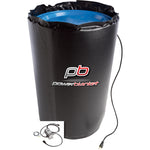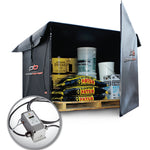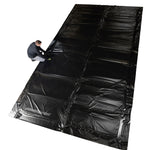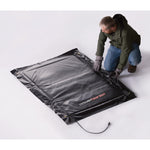You have no items in your shopping cart.
Article At-a-Glance
What is the Freezing Point of Engine Oil?
Engine oil begins to lose its flow characteristics and increase in viscosity at around 50°F, with a freezing point at -20°F, but full synthetic oils are better suited for cold weather as they maintain their effectiveness longer without thickening.
Key Takeaways
- Understand Viscosity Changes: Engine oil begins to thicken and lose its flow characteristics at around 50°F, impacting its ability to lubricate effectively in cold conditions.
- Freezing Point Details: While engine oil doesn't freeze like water, it can solidify at approximately -20°F, making it crucial to consider oil type for winter use.
- Synthetic vs. Conventional: Full synthetic oils are better suited for cold weather, maintaining their effectiveness without thickening due to the absence of waxes found in conventional oils.
- Impact on Engine Performance: Thickened oil can hinder engine startup and performance, emphasizing the importance of choosing the right oil for severe winter conditions.
- Preventive Measures: Utilize engine heaters or explosion-proof drum heaters to maintain oil viscosity and prevent freezing, ensuring optimal engine performance in cold climates.
How to Choose the Right Engine Oil
Picking the wrong engine oil for your vehicle or generator can ruin the motor. Don’t make the mistake of not knowing the right kind of engine oil for your application. Read on to learn how you can make the best decision for your needs.

$499.99 USD
3' x 4' Extra-Hot Motor & Engine Warming Blanket (120V)
Worried about the cold weather? We've got you covered with the best heating solutions to keep your car running smoothly.
Which engine oil is right for you
Knowing which oil to buy isn’t complicated, but you do need to know a few things in advance before making a purchasing decision. These include:
- Any engine specifications for different oil types
- The operating temperature of your application
- The operating temperature range of the oil
- Storage requirements for the oil
- Engine oil freezing point

How to find the viscosity rating that's best for your needs
The viscosity rating is probably the most important specification when choosing engine oil. It affects the oil's ability to flow and lubricate the engine, so you'll want to make sure you choose an oil with the rating that's best suited for your vehicle. You can find the rating in the product specifications on the bottle. We’ll also discuss this more later on in this article. For now, let’s learn about engine oil blends.
What factors to consider when choosing a synthetic blend or full synthetic oil
When choosing between a synthetic blend or full synthetic oil, there are several things to keep in mind:
- Performance requirements: Synthetic blends are often recommended for older vehicles or those with lower performance requirements, while full synthetic oils are typically recommended for newer, high-performance vehicles.
- Climate and driving conditions: Full synthetic oils are generally better suited for extreme temperatures, such as very cold or very hot environments, while synthetic blends may be more suitable for moderate climates.
- Price: Synthetic blends are generally less expensive than full synthetic oils, which may be a factor to consider if cost is a concern.
- Frequency of oil changes: Full synthetic oils typically provide better protection for longer periods of time, meaning that they may allow for longer intervals between oil changes. Synthetic blends may require more frequent oil changes.
- Manufacturer recommendations: Check the vehicle manufacturer's recommendations for the type of oil to use, as they may specify a synthetic blend or full synthetic oil.
The choice between a synthetic blend or full synthetic oil will depend on your specific vehicle and driving needs, as well as your budget and preferences. It's always best to consult with a trusted mechanic or refer to your vehicle's owner manual to ensure you're making the best choice for your engine.
How often you should change your engine oil, and what symptoms mean it's time for a change?
We’ve mentioned this above briefly, but now we’ll dive deeper into when you should change your oil. The frequency at which you should change your engine oil depends on several factors, such as the type of vehicle you have, the age of the vehicle, and the type of oil you use.
How often should I change my engine oil?
As a general rule of thumb, it’s recommended to change your engine oil every 5,000 to 7,500 miles, or every six months, whichever comes first. However, it's always best to refer to your vehicle's owner manual for the manufacturer's recommended oil change timeframe.

Symptoms that indicate it's time for an oil change
Regardless of how long it’s been since your vehicle’s last oil change, there can be signs that the oil needs to be replaced. The following symptoms can help you understand the current life of your oil and whether or not you need to change it:
- Dirty or Dark Oil: If your oil appears dark and dirty, it's a sign that it's time to change it. Over time, oil picks up dirt and debris, which can decrease its effectiveness and even wear down internal engine components.
- Low Oil Level: If your oil level is low, it could be an indication that it's time for an oil change. You might smell burning oil when operating your vehicle or see small oil puddles developing under it when parked.
- Engine Noise: If you hear knocking or tapping sounds coming from your engine, it could be a sign that your oil is old and dirty, and not lubricating the engine components properly.
- Decreased Engine Performance: If your engine is running less efficiently than usual, it could be because the old oil is not lubricating the engine parts correctly, leading to increased friction and decreased engine performance.
Changing your engine oil on a regular basis is essential to keep your engine running smoothly and efficiently. It's best to follow the manufacturer's recommendations for oil change intervals and to look out for symptoms that indicate it's time for a change.
The importance of using the correct weight of oil in extreme temperatures
When choosing which engine oil to use, it’s just as important to consider the weight of the oil in addition to other factors. Oil weight is measured in terms of viscosity, and different weights are recommended for use in different temperatures. Using the incorrect weight of oil can lead to engine damage. You can find the weight of the oil you need in the manufacturer’s product specifications or on the bottle itself.

Using the correct weight in the correct temperatures
In high temperatures, oil becomes thinner, or less viscous, while in low temperatures, oil becomes thicker or more viscous. If you use oil that is too thin in high temperatures, it can break down and not provide adequate lubrication, leading to increased wear on engine parts. The opposite is also true: using oil that is too thick in low temperatures can prevent proper oil flow, making it harder to start the engine and, again, will wear down moving engine parts.
Why changing your oil in different temperatures is important
The oil in your engine is responsible for lubricating the moving parts and reducing friction between them. In extreme temperatures, the oil needs to provide adequate lubrication to prevent metal-to-metal contact. Using the correct weight of oil ensures that it can properly lubricate the engine, preventing wear and tear on critical components. The correct weight of oil can also help to improve fuel efficiency by reducing engine friction and improving the overall performance of the engine.
Using the correct weight of oil in extreme temperatures is essential to keeping your engine in prime condition. It's important to refer to your vehicle owner's manual or consult with a professional mechanic to determine the appropriate oil weight for your vehicle and climate. Change out the oil as needed, especially if you’re operating your vehicle in different seasons.
Other engine temperature control solutions
Using specific weights of oil at different times of the year is an excellent practice if you live in an area that has varied climates. But what do you do with your off-season oil? This next section will break down how to properly care for oil when not in regular use.
How to store your oil
Properly storing engine oil until it’s needed for use involves more than just putting it on the shelf in your garage. Temperatures play a significant role in how long your oil can remain in storage. Many shops and garages will use industrial heaters to keep oil in a usable consistency. There are many industrial heaters for different environments that can help depending on how cold it gets in your area.
Our friends at the Petroleum Service Company have a great explanation of things you should consider when preparing to store oil:
Manufacturers recommend storing motor oil between 40 degrees and 80 degrees Fahrenheit. Extreme temperature changes impact oil viscosity, despite the presence of oil additives. If possible, keep the container of motor oil sealed and unopened until it is ready for use.
Storing motor oil in a cool, dry environment is crucial to prevent moisture from entering the bottle. Temperature changes can cause additive dropout. Additives fall out of suspension causing an uneven lubricant mixture that can lead to engine failure.
Essentially, always factor in the potential for temperature fluctuations when storing oil. You don’t want to discover that it's unusable the moment you need it.
Can engine oil freeze solid?
The engine oil freezing point is -20 F. However, oil will increase in viscosity to the point of losing its effectiveness beginning at 50 F. This is where full synthetic oils can come in handy.
Does full synthetic oil freeze?
Yes, but until it freezes there are far less issues with its viscosity. Full synthetic oils are often used in cold weather environments to keep engines going without the fear of becoming too thick. This is due to a lack of waxes or paraffin that exist in conventional oil that tend to clump up in low temperatures.
Does it hurt oil to freeze?
Engine oil that has frozen is still entirely usable. Once thawed to the point of use, it can be poured into any engine that requires it.
Preventing oil from freezing
As mentioned earlier, oil tends to thicken before it freezes as low temperatures increase the oil’s viscosity. Thickened oil and frozen oil should both be thawed before using, as it’s impossible to use in these states.

Explosion proof drum heaters are one way to safely store oil in cold environments to prevent freezing. Engine heaters can also help oil stay viscous enough while the oil is circulating the engine.













